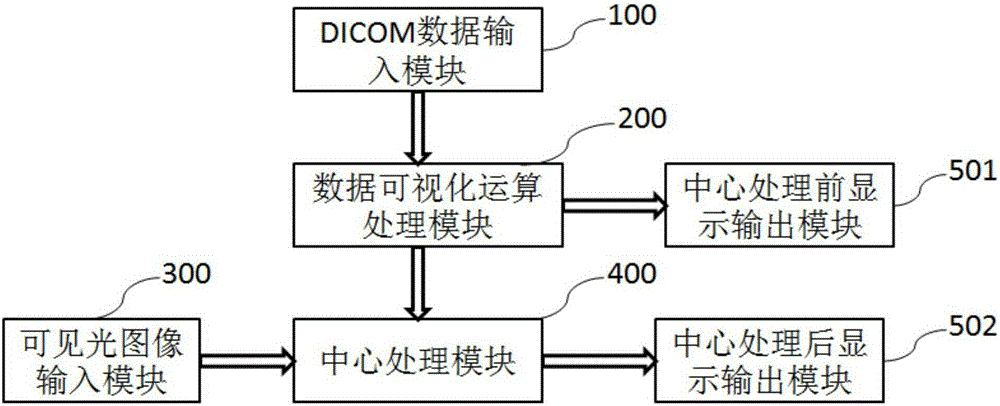Operative positioning system
A positioning system and surgical technology, applied in the field of surgical positioning systems, can solve problems such as volume limitations and difficulty in meeting configuration requirements, and achieve the effect of reducing requirements
- Summary
- Abstract
- Description
- Claims
- Application Information
AI Technical Summary
Problems solved by technology
Method used
Image
Examples
Embodiment 1
[0031] A non-enhanced CT scan of a patient with renal diverticulum found a stone buried in the renal parenchyma (diverticulolithiasis), and contrast-enhanced CT showed the inner lumen structure of the kidney and ureter (collecting system). The doctor uploads the CT data of the patient to the cloud server in the form of DICOM files. After data visualization processing, the 3D model data of the patient's kidney and the position data of the stone in the kidney are transmitted to the central processing module. The central processing module accepts the image data from the flexible ureteroscope camera and the 3D data from the data visualization processing module. Through registration and fusion, it can determine which relative position of the scene in the lens is in the patient's 3D model, and where it is buried. The required path of travel for stones in a diverticulum. In this way, along the path suggested by the central processing module, diverticular stones buried in the tissue ...
Embodiment 2
[0033]A patient with kidney tumors needs laparoscopic partial nephrectomy. The doctor uploads the patient's kidney CT data to the cloud server in the form of a DICOM file. After data visualization processing, the 3D model data of the patient's kidney, the location data of the tumor in the kidney and the location of the kidney blood vessels are transmitted to the central processing module. The central processing module is also located in the cloud, accepting the image data from the laparoscopic camera and the 3D data from the data visualization processing module. Through registration and fusion, it can determine the direction of blood vessels supplying kidney tumors under the kidney capsule, which can be displayed on the on wearable devices (glasses). The doctor thus selectively blocks only the blood vessels supplying the kidney tumor and completes the operation. It avoids the need to block larger arteries and veins in conventional methods, resulting in more extensive renal t...
Embodiment 3
[0035] A patient with peripheral lung cancer needs a bronchoscopic biopsy. The doctor uploads the patient's DICOM file to the cloud server. After data visualization processing, the 3D model data of the patient's lungs and bronchi at all levels, the location of the tumor in the lung and the location of blood vessels around the tumor are transmitted to the central processing module. The central processing module accepts the image data from the bronchoscope camera and the 3D data from the data visualization processing module. Through registration and fusion, it can determine which relative position of the bronchus lens is in the patient's 3D model, and which bronchi need to pass through to reach the tumor. Fork, whether there are blood vessels around the tumor that need to be avoided during biopsy, etc. It can even assist in the identification and selection of tumor margins for biopsy, because the tumor margins have a higher detection rate of cancer cells than the tumor center (...
PUM
 Login to View More
Login to View More Abstract
Description
Claims
Application Information
 Login to View More
Login to View More - R&D
- Intellectual Property
- Life Sciences
- Materials
- Tech Scout
- Unparalleled Data Quality
- Higher Quality Content
- 60% Fewer Hallucinations
Browse by: Latest US Patents, China's latest patents, Technical Efficacy Thesaurus, Application Domain, Technology Topic, Popular Technical Reports.
© 2025 PatSnap. All rights reserved.Legal|Privacy policy|Modern Slavery Act Transparency Statement|Sitemap|About US| Contact US: help@patsnap.com

